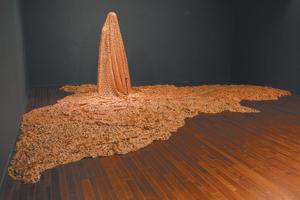Most people think the worst thing about a Band-Aid is taking it off. But for Andrew McPhail, opening the package is the biggest pain. The Hamilton-based artist’s sculptural work all my little failures is constructed from more than 60,000 individual bandages, all of which had to be removed from their wrappings.
“At a few points I had these Band-Aid sweat shops set up where I got friends to help me with opening them,” he laughs. “The first 10,000 took over a year to deal with, but by the time I got to the last 15,000 I was able to do it in a month. Partly because I had help and partly because I got really good at opening the packages.”
The resulting work is a full-body covering suggestive of a burka. McPhail wears the garment in public spaces, sometimes while handing out bandages or hand sanitizer, other times while simply walking slowly through the streets.
McPhail says the intimidating, flesh-toned figure is difficult for casual observers to understand. Though some immediately get the humorous undertone and want to engage with him, others react in fear, giving a wide berth or literally running the other direction. When he performed in Fredericton, some tried to give him change — they thought he was a panhandler.
“People can’t tell what gender I am when I’m wearing it, which is part of what freaks them out,” he says. “The first few times I performed, I started feeling really sad, because people were responding with so much fear it left me feeling very alone. But as I’ve done it more, it’s become sort of a challenge to be more assertive and confrontational.”
But the work isn’t just about disrupting public space through unexpected interactions. It’s also a metaphor for McPhail’s journey living with HIV. Mirroring the experience of his status, wearing the piece makes him a highly visible presence in the world, while simultaneously hiding his true identity.
“When I’m wearing it, people see only the object and not the person,” he says. “It’s a lot like being HIV-positive in that people often see only the disease and not the individual. It’s been oddly empowering to do, because it’s become as much about asserting my presence as a positive person in the world as it is about the original issues I set out to explore.”
McPhail first became interested in the bandages because of their disposability (his next work is made out of Kleenex), but references to healthcare and disease emerged during the process.
“I wasn’t thinking of the whole clean-versus-dirty paradigm that comes up around HIV status initially, but it does present itself in the work,” he says. “The idea of an object that starts out clean then comes in contact with the body and gets thrown away became suggestive of the way HIV-positive people are sometimes viewed.”
Though he’s been living with HIV since 1993, all my little failures marks the first time McPhail has addressed the subject in his work. Revealing his status to the world has been a sort of second coming out.
“It’s been liberating to be able to be open about it,” he says. “I was out to a small circle of friends, but I felt it was important to come out in a more public fashion. The more people who know someone who’s positive, the easier it will be for us to accept the fact that it’s just a medical condition. Understanding that will help lessen the stigma people who are living with this have to face.”


 Why you can trust Xtra
Why you can trust Xtra


